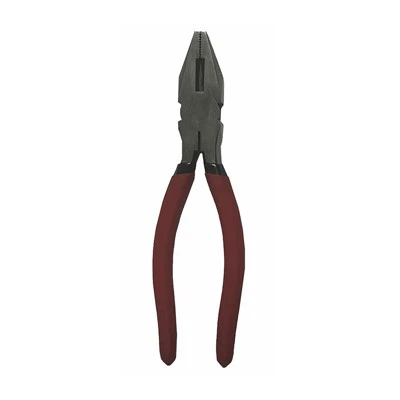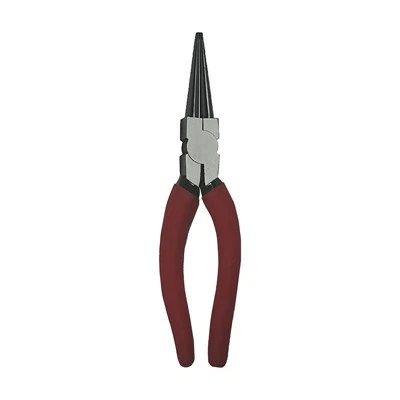In the realm of soldering work, the selection of appropriate tools is crucial to achieving high - quality results. As a supplier of Long Reach Flat Nose Pliers, I often receive inquiries about whether these pliers can be effectively used for soldering tasks. In this blog post, I will delve into the capabilities of Long Reach Flat Nose Pliers in soldering work, exploring their features, advantages, limitations, and comparing them with other types of pliers commonly used in the soldering process.
Features of Long Reach Flat Nose Pliers
Long Reach Flat Nose Pliers are characterized by their extended jaws and flat, parallel surfaces. The long reach allows users to access hard - to - reach areas, which is particularly useful when working on complex electronic circuits or in confined spaces. The flat nose design provides a stable gripping surface, enabling precise manipulation of small components. These pliers are typically made of high - quality steel, ensuring durability and resistance to wear and tear.
Advantages of Using Long Reach Flat Nose Pliers in Soldering
1. Precise Component Placement
One of the primary advantages of using Long Reach Flat Nose Pliers in soldering is the ability to precisely place components. The long jaws can reach into tight spaces and hold components firmly in place while soldering. For example, when soldering surface - mount devices (SMDs) on a printed circuit board (PCB), the flat nose of the pliers can grip the SMDs accurately, preventing them from shifting during the soldering process. This precision is essential for ensuring proper electrical connections and avoiding short circuits.
2. Heat Dissipation
Another benefit is the heat dissipation property. The metal construction of the pliers can act as a heat sink to some extent. When holding a component during soldering, the pliers can absorb and dissipate a portion of the heat, reducing the risk of overheating the component. This is especially important for heat - sensitive components such as integrated circuits (ICs). By using Long Reach Flat Nose Pliers, the solderer can better control the temperature of the component and protect it from damage.
3. Versatility
Long Reach Flat Nose Pliers are versatile tools that can be used for a variety of soldering tasks. They can be used not only for holding components but also for bending and shaping wires. For instance, when preparing wires for soldering, the pliers can be used to straighten or bend the wires to the desired shape, making it easier to connect them to the PCB or other components.
Limitations of Long Reach Flat Nose Pliers in Soldering
1. Limited Insulation
One of the limitations of Long Reach Flat Nose Pliers is the lack of insulation. Since they are made of metal, there is a risk of electrical conduction if the pliers come into contact with live electrical circuits during soldering. This can be dangerous for the user and may also cause damage to the circuit. To mitigate this risk, some soldering tasks may require the use of insulated pliers.


2. Difficulty in Handling Small Components
Although Long Reach Flat Nose Pliers are useful for reaching into tight spaces, they may not be the best choice for handling extremely small components. The relatively large size of the jaws can make it difficult to grip very tiny SMDs or delicate wires. In such cases, specialized micro - pliers may be more appropriate.
Comparison with Other Types of Pliers for Soldering
1. American Type Flat Nose Pliers
American Type Flat Nose Pliers are another popular option for soldering. They are similar to Long Reach Flat Nose Pliers in terms of the flat nose design, but they may have different jaw lengths and widths. American Type Flat Nose Pliers are often used for general - purpose soldering tasks and are known for their durability. However, they may not have the extended reach of Long Reach Flat Nose Pliers, which can be a drawback when working in deep or narrow spaces.
2. German Type Round Nose Pliers
German Type Round Nose Pliers have a round - shaped jaw, which is different from the flat nose of Long Reach Flat Nose Pliers. These pliers are mainly used for creating loops and bends in wires. They are not as suitable for holding components during soldering as Long Reach Flat Nose Pliers because the round shape may not provide a stable grip on flat - surfaced components.
3. American Type Round Nose Plier
American Type Round Nose Plier also have a round - nose design. Similar to German Type Round Nose Pliers, they are more focused on wire - bending tasks rather than component - holding during soldering. The round nose can be used to create smooth curves in wires, but it lacks the flat surface required for gripping components securely.
Best Practices for Using Long Reach Flat Nose Pliers in Soldering
1. Proper Cleaning
Before using Long Reach Flat Nose Pliers for soldering, it is important to clean them thoroughly. Any dirt, grease, or oxidation on the jaws can affect the gripping ability and the quality of the soldering. A simple cleaning with a wire brush or a mild solvent can help maintain the performance of the pliers.
2. Correct Grip
When using the pliers to hold components, it is essential to use the correct grip. The component should be held firmly but not too tightly to avoid damaging it. The pliers should be positioned in a way that allows easy access to the soldering area without obstructing the view.
3. Safety Precautions
As mentioned earlier, due to the metal construction of the pliers, safety precautions should be taken. When working on live circuits, make sure to use insulated pliers or take appropriate measures to avoid electrical contact. Also, wear safety glasses to protect the eyes from any flying debris during soldering.
Conclusion
In conclusion, Long Reach Flat Nose Pliers can be a valuable tool for soldering work. Their long reach and flat nose design offer several advantages, including precise component placement, heat dissipation, and versatility. However, they also have some limitations, such as limited insulation and difficulty in handling very small components. When compared with other types of pliers commonly used in soldering, Long Reach Flat Nose Pliers stand out for their ability to access hard - to - reach areas.
If you are involved in soldering work and are looking for high - quality Long Reach Flat Nose Pliers, I encourage you to reach out for a purchase negotiation. Our pliers are made with the highest standards of quality and craftsmanship, ensuring reliable performance in your soldering projects. Whether you are a professional solderer or a hobbyist, our products can meet your needs. Feel free to contact us to discuss your requirements and explore the possibilities of working together.
References
- "Hand Tools for Electronics: A Comprehensive Guide", by John Smith, 2020.
- "Soldering Techniques and Best Practices", published by the Institute of Electrical and Electronics Engineers (IEEE), 2019.





